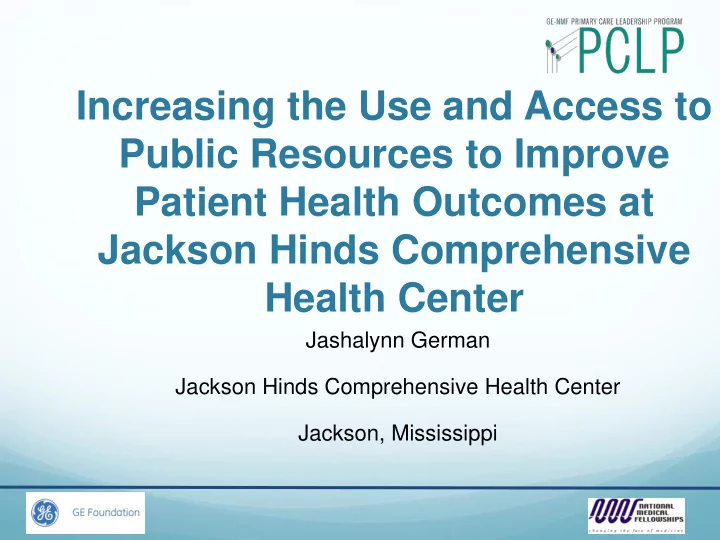

Increasing the Use and Access to Public Resources to Improve Patient Health Outcomes at Jackson Hinds Comprehensive Health Center Jashalynn German Jackson Hinds Comprehensive Health Center Jackson, Mississippi
Introduction A common aspect of Jackson Hinds Comprehensive Health Center (JHCHC) and other CHCs alike is the mission to provide primary and preventative healthcare and social services to its patients. CHC’s serve a complex patient population that provides undoubtedly evidence of the Biopsychosocial Model
Background Mississippi suffers disproportionately from chronic diseases such as cardiovascular disease, diabetes, kidney disease and cancer. Higher Mortality Rates for these disease compared to National averages According to the 2004-2013 Mississippi State Plan, cardiovascular disease was the cause of 41% of all deaths in the state in 2011
Methodology Week long “mini rotations” Women’s Health, Adult Medicine and Pediatrics Subjective and objective data collection via patient interviewing and electronic medical records Windshield Survey Parks/ Green Space Healthy Food Options Create Patient Resource Book
Results Common Medical Issues Adult Medicine- HTN, DM, Gout, Excessive Alcohol/ Tobacco Use Women’s Health - Late Prenatal care, STI’s Pediatrics- asthma, obesity and eczema Common social issues Can’t afford medication or visits Teenage pregnancy Low education From windshield survey able to assess which communities have green space and healthy eating options
Discussion It is not possible to discuss improved patient health outcomes without first discussing the social determinants that directly effect patient’s health Obesity, sedimentary lifestyles and excessive alcohol/tobacco are common risk factors for numerous chronic diseases But these are all modifiable factors and so I chose to focus the project on these aspects.
Discussion Strengths: Patient’s social needs were assed through conversational data collection. This eliminated literacy, reading level and educational level biasness. Conducted mini rotations in different departments at different clinic sites, which gave a more accurate depiction of general patient population Weaknesses Time constraints Future Research direction Conduct windshield survey on adjacent major cities
Recommendations Continue to take hands on approach to rectify social disparities increase patient awareness about resources available in the community and national level Increase the use of printed patient education material Increase the social services staff placed in clinics
Conclusion According to the biopsychosocial model, social factors do indeed play a direct role in the overall health of an individual. By continuing to target modifiable risk factors and social disparities we should see an increase in patient outcomes
Acknowledgements Dr. Chapman and her wonderful executive team! Dr. Assad, Dr. Flantroy, Dr. McNair, Dr. Rayford, Dr. Rice, Dr. Hutchinson, Dr. Griffin, Jackson Hinds Comprehensive Clinics Dr. Tonore, University of Mississippi
Recommend
More recommend